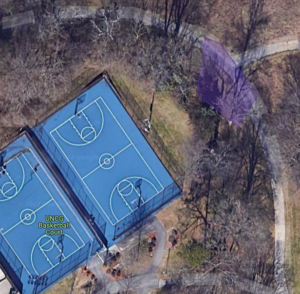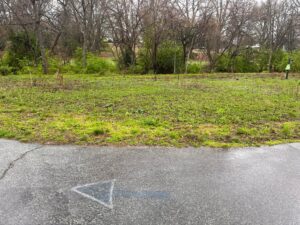
A project promoting sustainability in the arts is sprouting on campus—literally and figuratively—thanks to the passion and initiative of two CVPA faculty members. Leah Sobsey (Assistant Professor of Photography) and Tara Webb (Lecturer in Costume Technology) are creating a pollinator garden, which will soon be planted on a plot of land near UNCG’s outdoor basketball courts.
Sobsey had been toying with the idea of a garden artspace and a practice that would integrate plants and photography. Webb had been awarded the Office of Sustainability’s faculty fellowship and was working on a project to develop dyes from native plants to be used in preparing fabrics for theatrical costumes. They realized their research and personal interests overlapped and could bear greater fruit when combined.
They hope the garden will be a place where students and faculty can participate in supporting the ecosystem and highlight the importance of sustainable practices in several arenas. According to Webb:
“We have to do this. There’s a huge climate crisis that is happening, and we need to do anything we can to create dialogue in spaces anywhere about the reality of it.”
Sobsey sees an opportunity to use the garden for a place to photograph nature and to use the plants in the darkroom:
“Historically photography is terrible for the environment, so I want to work on creating a more eco-friendly art form by moving into plant-based printing practices such as using the plants as emulsion or printing directly onto plants. We’ll be able to use the plants in our photographic processes then talk about the issues of climate change. I’m so interested in this kind of overlap of science and art and how the two can have a conversation.”
Webb incorporates plant-based projects in her costume classes and says she’s interested in connecting those with the idea of place-making:
“In our age of technology we’re so disconnected from the spaces that we’re in because we’re so focused on our phones and other devices. I like the idea of connecting to the natural world and using plant-based education where you get students out into nature to do projects that are related to the space that they’re in. In every place there’s a local color palette based on the plants that are available. Using this local color in dyeing fabrics is a way to connect to a space.”
The majority of the plants in the garden will be native to North Carolina or the Southeast. Sobsey and Webb are working with the local Agriculture Extension Agency

and the Peabody Park Association to determine the plants to be used. Initial funding is coming from an Undergraduate Research and Creativity Award, and they have applied for long-term support from UNCG’s Green Fund. Ground will be broken soon, and approval has been given to hire two students to help with the planting and maintenance of the garden this summer.
In addition to arts and natural sciences, Sobsey says the project has a history angle, too:
“The site of the garden sits on the old Woman’s College Amphitheater, so we’re talking about bringing the history of the place into the new garden. The area has been taken over by invasive plants which were going to be ripped out anyway, which is great for us because we’ll probably unearth some of the old rocks and boulders. It could be pretty interesting.”
Sprung from a collaboration, the garden promises to be a place for more collaboration and interaction across campus and with the community. According to Webb:
“So often, not only are we in our own personal bubbles but we’re also in our school bubbles, and there’s not much chance for me as a Lecturer in Theatre to interact with my colleagues in the other schools. But there’s such an alignment of art and science in both mine and Leah’s processes, and my dream is to bring students together to do projects.”
Sobsey agrees: “It’s a little bit more difficult to do that in the classroom because of how curricula are structured. But if we can step out of that and bring our students to this destination we can utilize it in an interdisciplinary way.”
The two laugh when they talk about the size of the land they’re starting on, but they have big dreams for how it might grow.
“I keep reminding people it’s small,” says Webb. “It’s not a meadow. We can’t manage a meadow.” Sobsey agrees: “It’s a garden. Actually it’s the idea of a garden. But I would love for it to be bigger and more visible one day. It could be an outdoor classroom space, maybe with actual infrastructure like a tent and benches, that people from all over campus could use. It’s amazing how the learning shifts when I take my students outside. It’s like they immediately connect with each other.”
Webb adds: “We’ve also been thinking about ways to link it to other spaces on campus and in the community. For example, maybe there’s a container garden at Greensboro Project Space or other places around town, and in the container is a sign directing people to check out the pollinator garden on campus.”
As if the list of uses for this little plot of land isn’t long enough, there is one more outcome that’s envisioned, one that Sobsey says might the most positive of all:
“We also see this garden as a healing space. That feels really important for our students who have gone through so much. I think we all know just how high the cases of anxiety and depression are after these past two years. There is so much research already about how being in the natural world, especially in gardens, can help comfort and heal people. There’s a lot to be said for going back to basics. You know, sitting in a space and observing what’s around you, listening to the sound of your own breath. We don’t often give ourselves the opportunity to do that.”
Story by Terri W. Relos